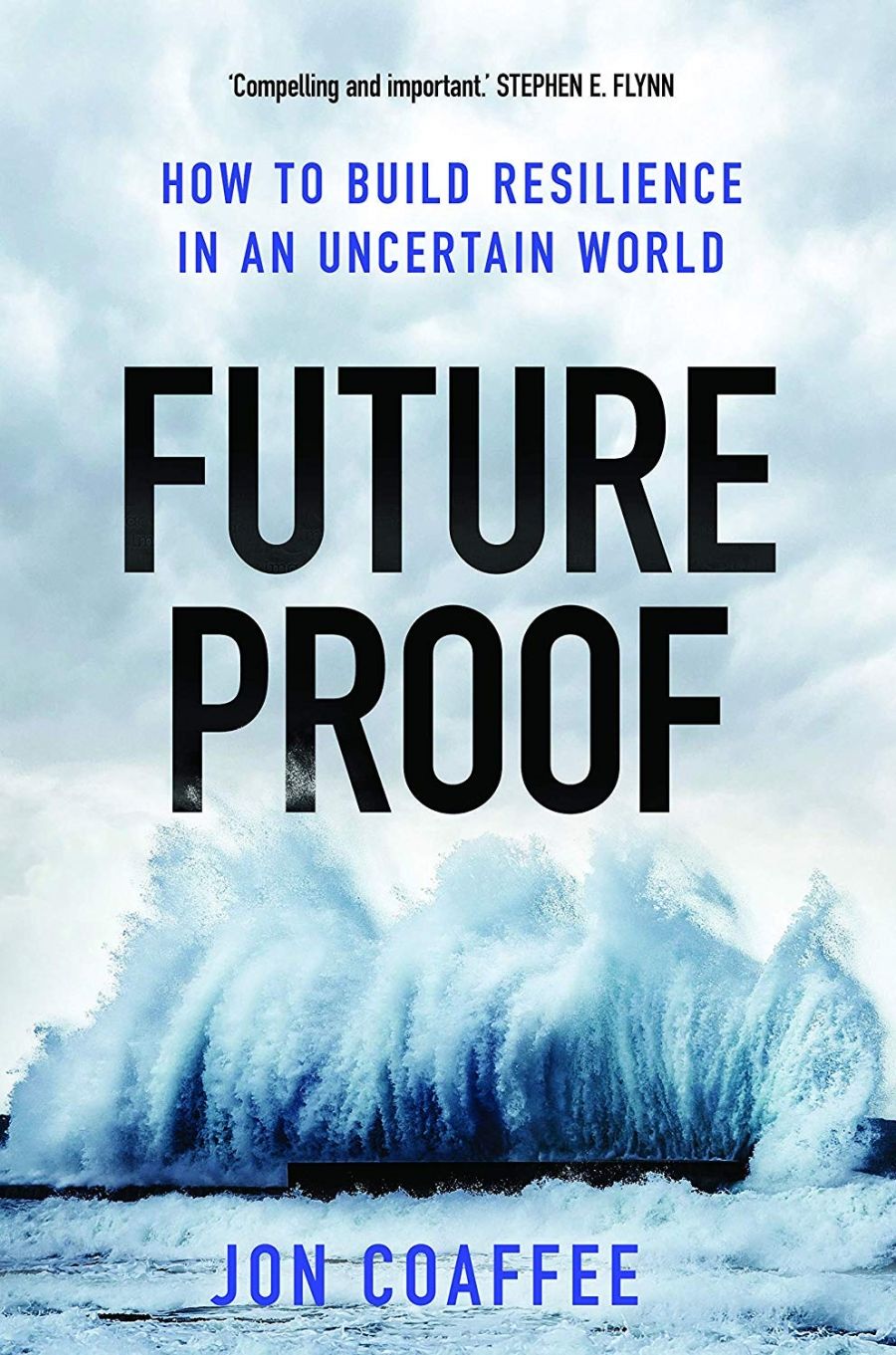
- Free Article: No
- Contents Category: Society
- Review Article: Yes
- Custom Highlight Text:
In Future Proof, Jon Coaffee, professor in urban geography at the University of Warwick, asks readers to imagine ‘a typical day’: radio reports of an impending cyclone; public-transport posters encouraging the reporting of ‘suspicious activity’; the path to an office (especially in a CBD) protected by hostile-vehicle-mitigation bollards. At work, computer systems will be tested for security from cyber attacks. The train home will be delayed due to a network complication, and the evening’s television will show the cyclone’s impact, discussing the relative ineffectiveness of hazard mitigation.
- Grid Image (300px * 250px):

- Book 1 Title: Future Proof
- Book 1 Subtitle: How to build resilience in an uncertain world
- Book 1 Biblio: Yale University Press (Footprint), $49.99 hb, 288 pp, 9780300228670
In this hellish yet recognisable quotidian cycle, the exception, Coaffee argues, has become the norm. New modes of thinking are necessary if human societies are to survive, let alone flourish. For Coaffee, there is a pressing need for change. He writes of an ‘implementation gap’ between the experienced reality of uncertainty and policy-making responses that are often reactive, short term, and based on addressing the problems of the past, rather than pre-emptive action to create a sustainable future. Such approaches derive from an outdated ‘steady state’ logic that assumes things will eventually return to ‘normal’. Instead, a new framework for analysis is necessary. While much of the book focuses on the United States and the United Kingdom, it is an observation that is also painfully apparent in Australian political responses to the worsening impact of climate change and the securitisation of national political debate.
The fundamental change is that humanity faces new types of ‘mega-risk’, some of which may be existential. Viable future societies depend on actions we take now. In the United States, 2017 was the costliest year on record for disasters. Drought, flooding, hurricanes, bushfires, and tropical storms caused more than US$300 billion in damage. Coaffee rightly criticises the idea that these are in any way ‘natural’, a term that blinds us to human agency. They are not ‘rare and unknowable events’ but a consequence of human activity, carbon emissions, and inequitable forms of social and economic organisation. The growing impact of disasters is, Coaffee argues, a ‘baseline against which we must act’. ‘Adapt or die’ is the stark choice posed in the book’s final chapter.
Yet Future Proof is not a pessimistic book; it offers a conception of ‘progressive’ resilience around which to frame new thinking in response to growing uncertainty. Coaffee outlines the idea’s intellectual evolution. The 1755 Lisbon earthquake led Enlightenment thinkers to question the idea of divine fate and to posit early sociological and scientific causes for the catastrophe. By then, mathematical research into probability was leading to the development of the idea of risk. The notion that events were not ordained but had a likelihood that could be predicted underpinned subsequent forward-thinking ideas of risk management. With the ability to manage – and insure against – possible disruption, modern societies began to organise themselves around the reduction of risk. Ulrich Beck’s Risk Society (1986), published the same year as the Chernobyl nuclear disaster, examined the systemic way in which industrial societies organised themselves to deal with the risks of industrial modernisation itself. For Coaffee, resilience thinking is the next phase of this development. Previous conceptions of risk sought to ‘colonise the future’ based on the likely recurrence of past events. Yet these approaches are no longer appropriate given current levels of uncertainty and the ‘vast and complex interconnectivity of global systems’.
Contemporary resilience thinking also derives from ecological thinking that by the 1960s was describing the complex interconnection of ecological systems. Coaffee advocates a ‘bounce forward’ version of resilience that ‘generates new and innovative ways of thinking and organising’ rather than simply restoring a pre-disaster status quo (‘bounce back resilience’). Such innovative thinking seeks to ‘break through the positivist grid of social science’ of conventional risk management. Instead, ‘resilient approaches are more about relationships, connections, and contexts than about fixed rules and linear cause and effect assumptions’. For organisations and policy makers, resilience involves a triptych of ‘adaptability, flexibility, and agility’ to deal with threats to security and to critical infrastructure, economic shocks, disasters, and the climate crisis.
Disasters, he argues, are ‘where it all comes together’. They are not ‘natural’; the most vulnerable are often the worst affected (for example, Hurricane Katrina in New Orleans). People are often poorly served by an obsolete response architecture, and community coping mechanisms can be overlooked. Current funding prioritises response over more effective investment in risk reduction, while insurance is expensive, exclusive, and often simply not available. In conflict, the privatisation of war has created a ‘postmodern’ system of disaster capital in which the West ‘creates’ disasters and profits by responding to them.
Resilience has its critics and at times has a business-school nebulousness to it. In a scene from the political satire The Hollowmen, the prime minister wants to make a major policy announcement but has no substantive ideas. ‘Future Proofing Initiative’ was the impressive-sounding yet vacuous recommendation from the PM’s policy team. Resilience has also been seen as a Trojan Horse for further neoliberal reform. Coaffee walks between these lines, countering vagueness with practical examples and critiquing, inter alia, laissez-faire approaches to insurance and urban planning, especially in the United States. Instead, his is a progressive resilience that seeks to inform key policy areas and to reduce social vulnerability in the face of growing uncertainty about what the future may bring.


Comments powered by CComment